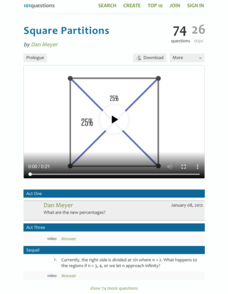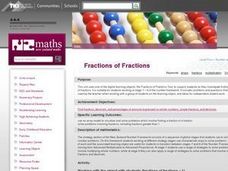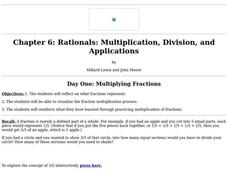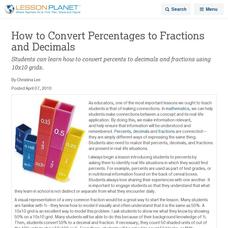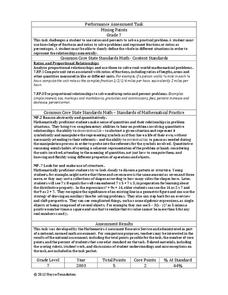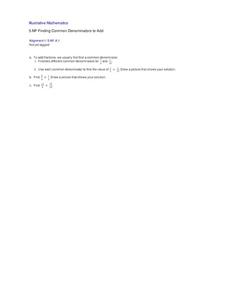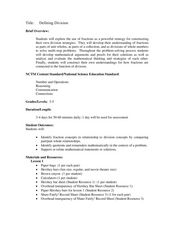Curated OER
Ratio, Rates and Percentages
In this ratio, rates and percentages worksheet, 8th graders solve 22 various types of problems related to ratios, rates and percentages. They first write ratios in lowest terms and describe each of comparison stated. Students also solve...
101 Questions
Square Partitions
Challenge your classes while developing their problem-solving skills. A square is divided neatly into four equal triangles by its diagonals until one diagonal is moved from a vertex to the midpoint of one side. Now, scholars must devise...
Rice University
Intermediate Algebra
Algebra concepts are all wrapped up in one nice bow. The resource combines all the concepts typically found in Algebra I and Algebra II courses in one eBook. The topics covered begin with solving linear equations and move to linear...
Curated OER
The Good, The Bad, The Ugly
Sixth graders examine the causes of the stock market crash of 1929. In this integrated math/history unit on the stock market, 6th graders study, research, and read stocks, visit a local bank, and create a PowerPoint to show the...
Curated OER
Developing the Concept: Rates
Learners discover how to use the knowledge of unit rates to understand equivalent ratios and solve real-world problems. They are given word problems to solve using equivalent ratios. Tables are also covered in this resource.
Curated OER
Egyptian Fractions
Sixth graders take a brief look at what is known about Egyptian Fractions. These are unit fractions - fractions whose numerator is one. We look at how fractions can be represented in terms of Egyptian Fractions. Finally we suggest a web...
Curated OER
Fractions of Fractions
Fourth graders use an online tool entitled the "Fraction of Fractions" tool to examine how to find a fraction of a fraction. They apply the array tool to problem solving situations. They complete paper folding activities in which they...
Curated OER
Multiplying Fractions
Fourth graders reflect on what fractions represent and visualize the fraction multiplication process. They reinforce what they have learned through practicing multiplication of fractions.
Curated OER
Divide by a Unit Fraction
In this dividing by unit fractions practice activity, students sharpen their problem solving skills as they solve 6 story problems.
Illustrative Mathematics
Voting for Two, Variation 4
After elections, the total amount of votes is not specified but the ratio of votes is. Your learners' job is to determine the fraction of votes John received above half of all votes. The problem can be solved abstractly or by other...
Curated OER
How to Convert Percentages to Fractions and Decimals
Students can learn how to convert percents to decimals and fractions using 10x10 grids.
Curated OER
Estimating With Fractions
Seventh graders, exploring methods to estimate fractions, take notes on estimating fractions, 7th graders write letters to explain the process of estimating fractions and mixed numbers to someone who does not know the concept. Students...
Curated OER
Recipe: Unit Rate
Young scholars solve problems using ratios and proportions. In this algebra lesson, students identify the unit rate and convert between fractions and decimals. They create graphs from their data.
Noyce Foundation
Mixing Paints
Let's paint the town equal parts yellow and violet, or simply brown. Pupils calculate the amount of blue and red paint needed to make six quarts of brown paint. Individuals then explain how they determined the percentage of the brown...
EngageNY
Creating Division Stories
Create your own adventure story ... well, not really. The fifth lesson in a 21-part series has pairs create story contexts for division problems. The lesson presents a step-by-step process for pupils to follow in writing such stories.
Noyce Foundation
Cereal
Find the best protein-packed cereal. The short assessment task covers equivalent and comparing ratios within a context. Pupils determine the cereal with the highest ratio of protein. A rubric helps teachers with point allotments for...
Illustrative Mathematics
Finding Common Denominators to Add
Finding common denominators is an important strategy when adding fractions with unlike denominators. In the first two questions in this three-question task, fifth graders are asked to combine fractions and draw a picture to show their...
Curated OER
Finding Common Denominators to Subtract
Subtracting fractions with unlike denominators can be overwhelming, but in this task, 5th graders work systematically to break down the procedure through three questions. The first two questions ask for pictures to be drawn along...
Curated OER
Drinking Juice
Pictures, number lines, decimal equivalents, or Cuisenaire rods can be used to show insight into the meaning of multiplying fractions.Here, Alisa drinks 3/4 of 1/2 liter of juice. To find the total volume of the juice that Alisa...
Curated OER
Defining Division
Upper graders explore division through fair-shares. They will review fair shares and fractions as a segway into division. They start by playing "Share Fairly" game and create mathematical arguments for solving problems. Manipulatives and...
Illustrative Mathematics
Salad Dressing
Aunt Barb's salad dressing is a mixture of oil, vinegar, salt, herbs, and a pinch of math. Fifth graders add the fractional measurements of ingredients to find a total amount. The fractions have unlike denominators. After finding the...
Illustrative Mathematics
How Much Pie?
The connection between fractions and division is not always intuitive for 5th graders. Pie, on the other hand, is something 5th graders can connect with. Multiple pies divided among multiple people provide the platform for your...
Beacon Learning Center
Bowling Over the Order of Operations
Upper graders will solve equations using order of operations, and create equations that to play a fun math bowling game. They will bowl using dice to practice operations. Extensions are also included.
Centre for Innovation in Mathematics Teaching
Ratio and Proportion
Middle schoolers review the definition and rules for equivalent fractions. Additionally, they are introduced to equivalent ratios. They write examples of ratios from the board, and they come to the board to write the correct equivalent...

